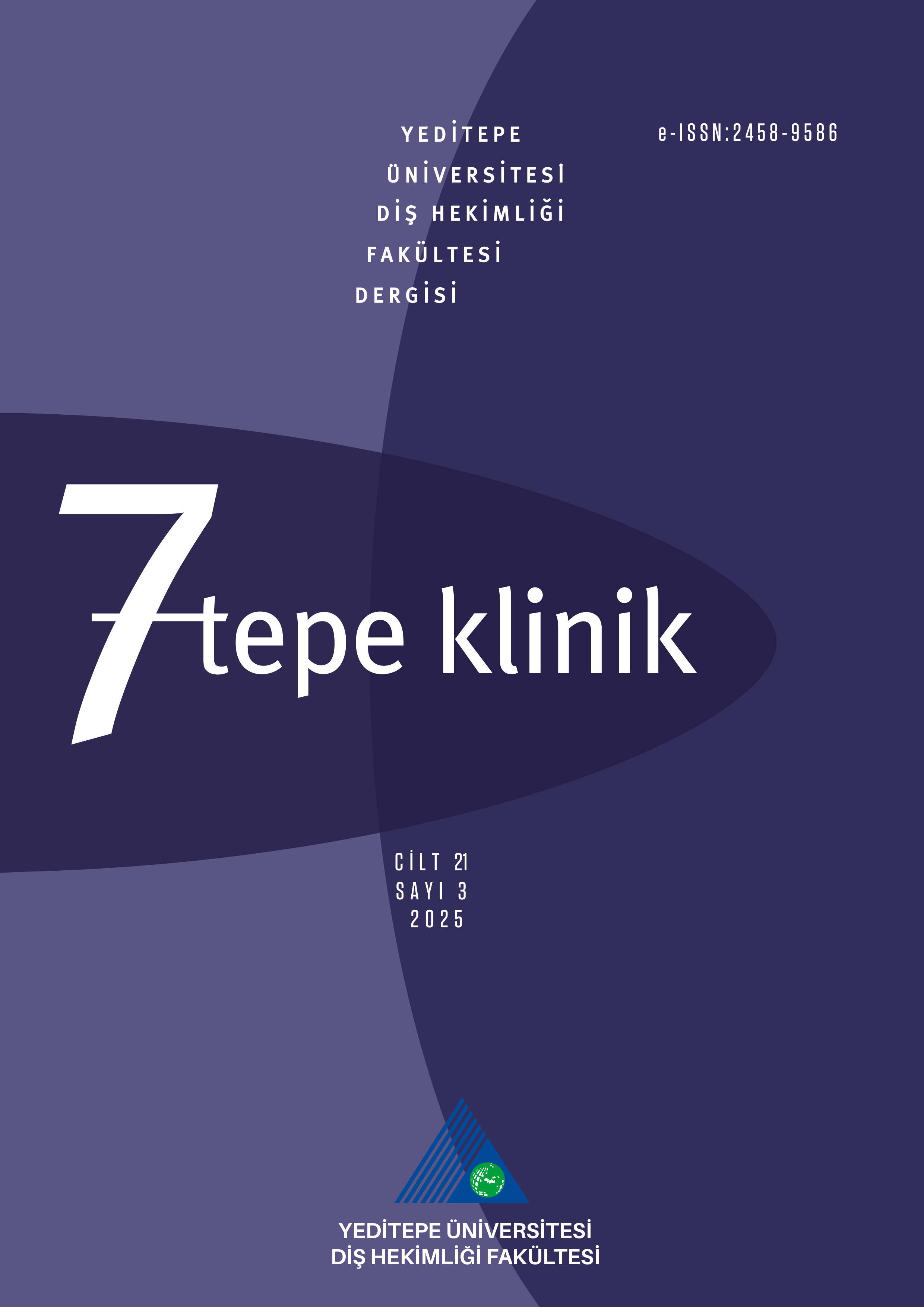CAD-CAM Plak ile Yapılmış Vestibül Derinleştirme Operasyonunun Sonuçlarının Geleneksel Vestibuloplasti Operasyonu Sonuçları ile Karşılaştırılması
Zeynep Beyza Kırıştıoğlu1, Ferit Bayram1, Ceren Küçük2, Gökhan Göçmen11Marmara Üniversitesi, Diş Hekimliği Fakültesi, Ağız, Diş ve Çene Cerrahisi Anabilim Dalı, İstanbul2Marmara Üniversitesi, Diş Hekimliği Fakültesi, Protetik Diş Tedavisi Anabilim Dalı, İstanbul
GİRİŞ ve AMAÇ: Bu çalışmanın amacı, vestibül derinliği yetersiz olan dişsiz hastalarda serbest diş eti greftiyle beraber yapılmış vestibüloplasti operasyonunda, CAD-CAM plak ve konvansiyonel süturla vestibül derinliğinin stabilizasyonunun karşılaştırılmasıdır.
YÖNTEM ve GEREÇLER: Marmara Üniversitesi Diş Hekimliği Fakültesi Ağız, Diş ve Çene Cerrahisi kliniğine 2021-2023 yılları arasında başvurmuş ve mandibula anterior bölgeye vestibüloplasti operasyonu yapılmış 22 hasta çalışmaya dahil edilmiştir. Hastalardan 11inde operasyon sonrası vestibül derinliğinin stabilizasyonu CAD-CAM plakla sağlanmış, diğer hasta grubunda ise konvansiyonel yöntemle süturla sağlanmıştır. Hastalardan operasyon öncesi ve sonrası alınan ölçüler 3D taranıp çakıştırıldı. Operasyon sonrası kazanılan yüzey alan ölçümleri karşılaştırıldı.
BULGULAR: Sonuçların istatistiksel analizinde, iki farklı ameliyat yönteminin etkinliklerinin karşılaştırılması amacıyla, CADCAM ve Konvansiyonel gruplardaki yüzdesel değişimlerin ortalamaları bağımsız örneklem t testi (unpaired t test) ile değerlendirildi. CAD-CAM grubunda ortalama yüzde değişim %65,27 olarak bulunurken, Konvansiyonel grupta bu oran %49,03 olarak gözlemlendi. Yapılan istatistiksel analiz, her iki grup arasında istatistiksel olarak anlamlı bir farkın olduğunu gösterdi.
TARTIŞMA ve SONUÇ: Plakla fiksasyonun, vestibül derinliğinin stabilizasyonunda daha iyi sonuçlara neden olduğu görüldü. Hasta sayısı arttırılarak ve takip süresi uzatılarak daha net sonuçlara ulaşılabilir.
Anahtar Kelimeler: CAD-CAM, vestibüloplasti, preprostetik oral cerrahi.
Comparison of the Results of Vestibuloplasty Operation Performed with CAD-CAM Plate with the Results of Traditional Vestibuloplasty Operation
Zeynep Beyza Kırıştıoğlu1, Ferit Bayram1, Ceren Küçük2, Gökhan Göçmen11Department of Oral And Maxillofacial Surgery, Faculty of Dentistry, Marmara University, Istanbul, Turkey2Department of Prosthodontics, Faculty of Dentistry, Marmara University, Istanbul, Turkey
INTRODUCTION: The aim of this study is to compare the stabilization of vestibule depth with CAD-CAM plate and conventional suture in vestibuloplasty operation performed with free gingival graft in edentulous patients with insufficient vestibule depth.
METHODS: Marmara University Faculty of Dentistry Oral and Maxillofacial Surgery clinic was consulted between 2021-2023 and 22 patients who underwent vestibuloplasty surgery in the mandibular anterior region were included. In 11 of the patients, stabilization of the vestibule depth was achieved with CAD-CAM plate after the operation, while the other patient groups were achieved with conventional attacks. The measurements taken from the patients before and after the operation were scanned and superimposed in 3 dimensions. Surface area measurements gained after the operation were checked.
RESULTS: In the statistical analysis of the results, the averages of the percentage changes in the CAD-CAM and Conventional groups were evaluated with the independent samples t test (unpaired t test) in order to compare the effectiveness of two different surgical methods. While the average percentage change was found to be 65.27% in the CAD-CAM group, this rate was observed to be 49.03% in the Conventional group. The statistical analysis showed that there was a statistically significant difference between both groups.
DISCUSSION AND CONCLUSION: It was observed that plate fixation resulted in better results in stabilizing the vestibule depth. More clear results can be achieved by increasing the number of patients and extending the follow-up period.
Keywords: CAD-CAM, vestibuloplasty, preprosthetic oral surgical procedure.
Makale Dili: Türkçe



